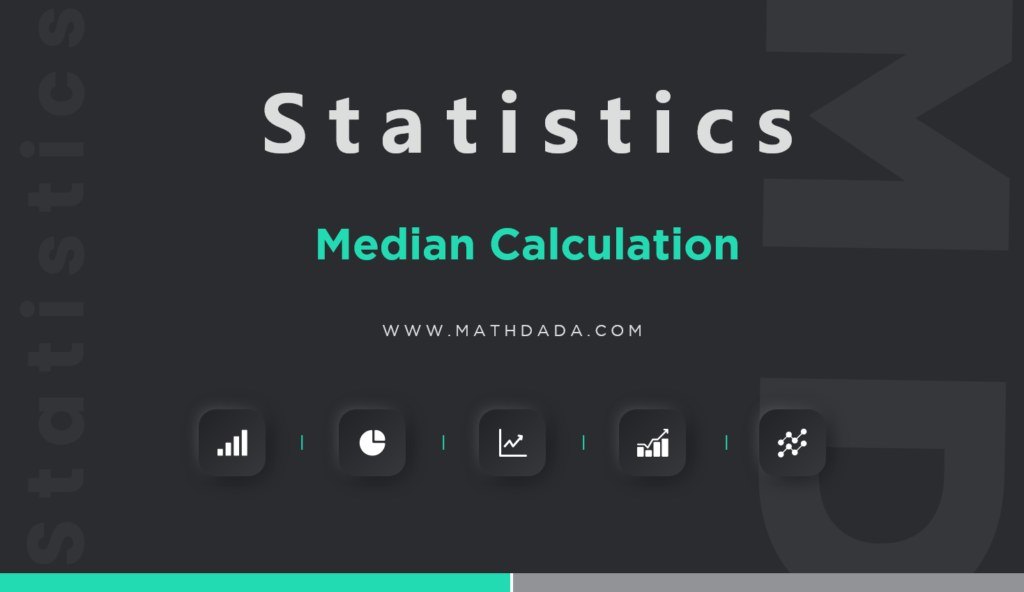Table of Contents
Median (Positional Average)
Before discussing about the Median Calculation formula, let us first try to understand what ‘Median’ actually stands for. Median of distribution is that value of the variable which divides it into two equal parts. In terms of frequency curve, the ordinate drawn at median divides the area under the curve into two equal parts. Median is a positional average because its value depends upon the position of an item and not on its magnitude.
Median of a set of values is the value which is the middle most value when they are arranged in the ascending order of magnitude. Median is denoted by ‘M’.
Median Calculation Processes
Individual Series
First arrange the data in ascending or descending order, the median = size of ((N+1)/2 )th item, where N is the total number of items in the series.
Case 1: If the number of items is odd, then the median is the middle value after the items are arranged in ascending or descending order of their magnitude.
Case 2: if the numbers of items are even in number, then the median is the arithmetic mean of two values after the items are arranged in ascending or descending order of their magnitude.
Discrete Series
Step 1: Convert the simple frequency of a series into cumulative frequencies.
Step 2: Determine the size of ((N+1)/2 )th item of the series, where N = ∑ f
Step 3: Find the median value corresponding to the size of ((N+1)/2 )th
Step 4: If the ((N+1)/2 )th is a whole number then ((N+1)/2 )th item gives the value of median. If ((N+1)/2 )th is in fraction, then arithmetic mean of (N/2)th and ((N/2+1)th item gives the value of median.
Continuous Series
Step 1: The frequencies are first converted into cumulative frequencies.
Step 2: Median class of the series is identified. It corresponds to that cumulative frequency which includes the size of (N/2)th item.
i.e., M = Size of (N/2)th item, where N = Sum of frequencies.
Step 3: The following formula is applied to determine the actual median.
\[M=l+\frac{\frac{N}{2}-cf}{f}\times i\]
Where,
l = Lower limit of median class.
cf = cumulative frequency of the class preceding the median.
f = Frequency of the median class.
i = Size of the median interval.
| Example 01 |
Find the median value of the following set of values 45, 32, 31, 46, 40, 28, 27, 37, 36, 41, 47, 50.
Solution:
Arranging in ascending order, we get: 27, 28, 31, 32, 36, 37, 40, 41, 45, 46, 47, 50. We have N = 12.
\[Median=\frac{12+1}{2}th.value=6.5th.value\]
We have to take the average of 6th and 7th value.
\[Median=\frac{37+40}{2}=38.5\]
| Example 02 |
Find the median value for the data shown in table given below
| x | 12 | 16 | 10 | 14 | 17 | 20 | 15 |
| f | 4 | 9 | 3 | 5 | 4 | 2 | 10 |
Solution:
Here, we have, N = 37
| x | f | Cumulative frequency |
| 10 | 3 | 3 |
| 12 | 4 | 7 |
| 14 | 5 | 12 |
| 15 | 10 | 22 |
| 16 | 9 | 31 |
| 17 | 4 | 35 |
| 20 | 2 | 37 |
\[M={{\left( \frac{N+1}{2} \right)}^{th}}value={{\left( \frac{37+1}{2} \right)}^{th}}value={{19}^{th}}value\]
Therefore, the median M is 15.
| Example 03 |
Find the median of the following data
| Weight in Kg | 30-35 | 35-40 | 40-45 | 45-50 | 50-55 |
| Frequency | 10 | 15 | 40 | 27 | 8 |
Solution:
As it is an exclusive type of interval, we organize the data as shown in the table below:
N = 10 + 15 + 40 + 27 + 8 = 100
| Weight Class | Frequency | Cumulative Frequency |
| 30-35 | 10 | 10 |
| 35-40 | 15 | 25 |
| 40-45 | 40 | 65 |
| 45-50 | 27 | 92 |
| 50-55 | 8 | 100 |
\[M=l+\frac{\frac{N}{2}-cf}{f}\times i\]
Where,
l = Lower limit of median class = 40
cf = cumulative frequency of the class preceding the median = 25
f = Frequency of the median class = 40
I = Size of the median interval = 5
\[M=40+\frac{50-25}{40}\times 5=40+\frac{25}{8}=43.125\]
Hence, the median weight is 43.125 kg.
Harmonic Mean |
Mode |


